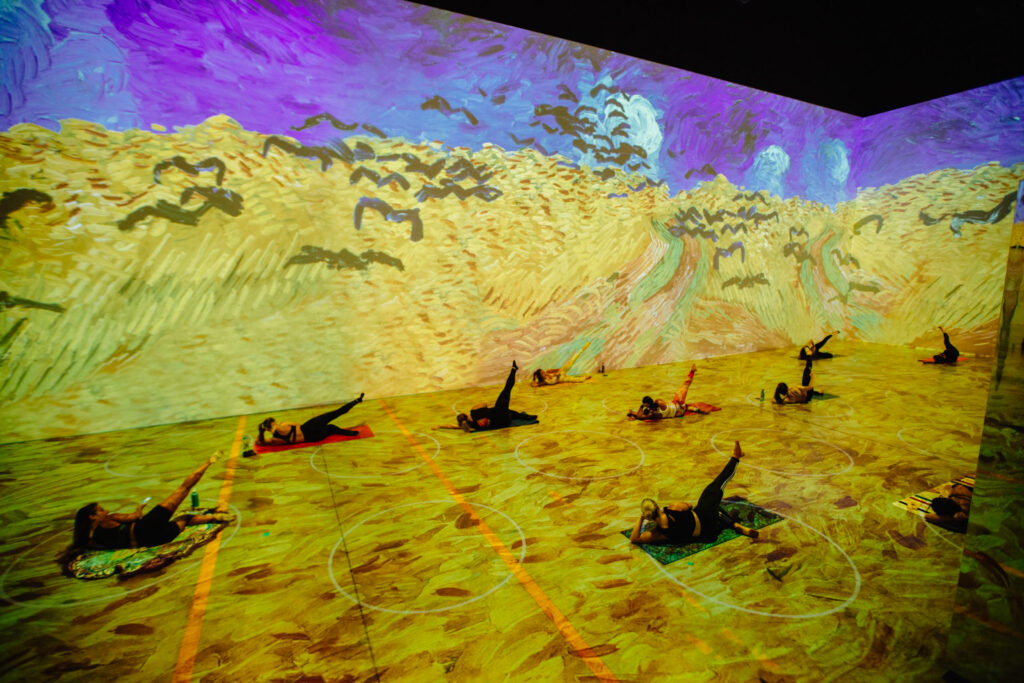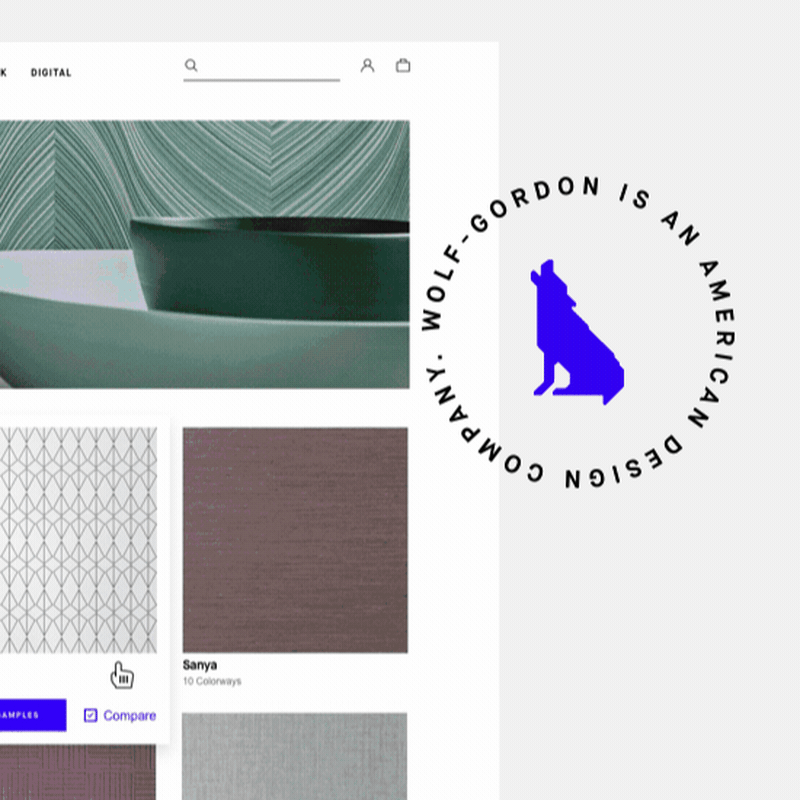Vibing with Van Gogh: How Gen-Z Marketing Revived the 132 Year Old’s Art

In the last few months, you have probably come across a mutual’s social media feed featuring a picture that held Van Gogh’s Starry Night painting projected on the background of tall walls. That’s because it seems as if the immersive experience overtook everyone’s summer plans. Including mine. The massive social media hype has turned it into a must visit and the ideal Instagrammable place of the summer.

As it turns out, the aforementioned Sunflower room is one of only two rooms offered in the exhibit. This is something not explicitly explained to guests looking to take part in such an impressive looking immersive experience. The way influencers present this to viewers also holds a sense of mystery, where not much is explained nor shown. The same can be said about their website. This seeming sense of mystery is a trend we later learn is entirely done on purpose.
Exactly, what is it? And why has it become so successful?
Van Gogh immersive experiences are presented as virtual exhibitions of the late artist’s paintings. Through this exhibition, the audience is taught about his life and the development of his art styles. Which is showcased through the digitally scanned paintings projected onto the 15,000 sqft walls. Although this specific exhibition format is not new, it has increased in popularity in the last couple of years. Variations such as: “Immersive Van Gogh”, “Van Gogh: The Immersive Experience”, “Imagine Van Gogh: The Immersive Exhibition” ,”Van Gogh Alive”, and “Beyond Van Gogh” have popped up all over. They all claim to be different ones…supposedly.
Besides the stated hefty ticket price of $55 and the estimated hour it takes to immerse oneself in the experience, information is still limited as to what the experience actually entails. Despite all of this, the exhibit has succeeded in attracting over 4 million visitors. Success has spanned across 20 US cities, translating into roughly $250 million in revenue. Places such as New York, New Orleans, San Francisco, have not only attracted the masses but have generated waitlists after completely selling out dates.
Then where, does the hype really come from? That’s simple, they know exactly who to target.
Embracing the Popularity of Van Gogh’s Starry Night

Even if one is not into arts, the name Vincent Van Gogh will be familiar. His paintings are seen as posters all around the walls of those Pinterest-inspired houses (a.k.a my house). Renditions of his most popular pieces have appeared in all types of media throughout time. For decades, people have flocked to museums holding his most precious work. All just to take an array of blurry zoomed in pictures that more than often are taken with people’s head on the way. Then proceed to boast on Instagram about having seen it in real life, and ultimately never looked back at it again. Nonetheless, the experience of seeing it in real life still remains an unforgettable one. Strangers’ heads in the way and all.
This is because Van Gogh appeals to the common audience. In “Gen Z” terms, he is relatable. His inspirations come from all simple subjects such as trees, flowers, and fields just to name a few. All which markets to a wider audience as compared to many famous abstract paintings. But this is definitely not the only reason why he has gotten so famous amongst this generation. Van Gogh truly stands out because of his story.
A Troubled Genius

Gogh is a “troubled genius”, fueled by beliefs that insanity and creativity go hand in hand. In today’s society, a need for validation and feeling seen is on the rise. As well as the increased importance and attention to neurodiverse individuals. Gogh’s struggle with mental illness makes him feel genuinely more relatable and dare I say, human, to his audience. This specific audience are in fact reporting higher rates of anxiety, depression, and distress. The World Health Organization reported a massive 25% increase in the global prevalence of anxiety and depression, in the first year of the pandemic alone. Being sad to have inspiration for the art justifies itself. He had a story that can be told with gusto, and one that people care about.
Van Gogh, therefore, is such a perfect headliner for an exhibition like this. One that not only caters to those looking for an escape from the everyday routine, but to a younger audience in search of a deeper life meaning. There have been other less popular immersive exhibitions featuring other artists/ public figures popping up. But have Monet, Frida Kahlo or even King Tut drawn out crowds of passionate viewers with the same sense of connection? Not at all.
Pandemic Timing

Although the immersive experience began at the heels of the recession in 2008, the show did not become a craze until after the pandemic. Likely due to the stark contrast of quarantine, physical installations still operating like this offered an extra level of excitement. Especially as people were looking for opportunities to get out of their house where they could escape their pandemic reality. A $55 price tag for an excuse to go out was more than justifiable after spending what felt like eternity inside. This was even more inviting when taking into account that visitors have not been spending money on bars, clubs, eating out, or in some cases toilet paper for the last two years.
In fact, compared to other generations, Gen Z and Millennials are more fulfilled by live experiences than purchasing an item of the same value; and are most likely to spend more than they can afford to do stuff with friends. This spending trend is only seeing an increase: “US consumers had approximately $2.8 trillion more in savings than they had in 2019, and many didn’t hesitate to dip into those savings as pandemic restrictions eased across the country.”
Health and Safety as a Strategy
In the midst of the pandemic, the organizers did a good job in reassuring people about safety measures by working actively around government safety requirements. First, they set up social distancing circles within the warehouse. When the government increased its restrictions effectively banning the walk-through experience in Toronto, they quickly pivoted to a “Gogh by Car” model. It was one of the first drive-in concepts during the pandemic. Clearly showing how flexible the organizers have been in their response by adjusting to the new normal and capitalizing on the social distancing opportunity. All while continuously finding creative ways to remain open and attract clientele.
Leveraging The Art-Tech Trend
In an era tied to technology such as ours, enjoying art is expected to be something more than just looking at a physical painting. Many are shying away from the typical museum experience or even subsequently traditional art itself. Indeed, the average attention span of a millennial is a whopping 12 seconds; and for Gen Zers, that number is an even more disappointing at 8 seconds. In that tiny 8-second time window, some wowing factors are needed to keep them engaged.
Art tech allows its audience to connect with art in a different, a more novel way, employing as many senses as possible. Audiences who have not been fully exposed to art tech before may find Van Gogh’s experience revolutionary and intriguing. They are not only viewing a painting, but they are also surrounded by the light, music, and movement that goes with it. Immersed in the experience completely.
In the case of Van Gogh Immersive, if one has ever dreamed of stepping into a painting, then this is it. The combination of classical music and subtle animations of Van Gogh brushstrokes bring the paintings into life. In some of the venues, the smell of cypress, cedar, sandalwood and nutmeg is present; a calculated strategy meant to transport people to orchards, gardens and fields. They aim to engage all of the guests senses at once. Making them no longer a passive observer but a figure within the world of Van Gogh. There is also a VR tour at the end that will give guests a unique insight into the artist’s life. Such as his time spent at the convent and in Arles, access to the secrets found in the letters he wrote to his brother, and much more.
At least, that is what the website sells the guests on.
However, looking at the reviews from actual visitors from within our team, the art tech comes off as a little bit, well… underwhelming.
“They make it seem like the whole room, including the floor and the ceiling, would be covered with moving images. It was just the walls and light projection on the floor. The main room is beautiful but it got old fast.”
“It is subpar. I liked the movement of the paintings, but it still left me feeling like $50 was too expensive to see something that might have been on Youtube”
But don’t just take our teams’ word, let’s look at what we found from other patrons online:
“Just some random projections and music, I can’t say I really learned anything new about Van Gogh there. Don’t waste your money. ”
“Other than being overcrowded and overpriced, it was just a plain and cold display of Van Gogh’s paintings on a screen. Terrible definition, no explanations at all. Definitely not worthy.”
Upselling Mystery, Downplaying Experience
If one is going to the experience expecting a marvelous show of art, they may actually be disappointed. Not because the tech is not there, it is! However, according to reviews it is also underwhelming for its price tag. The mystery factor shown through Instagram turns out to be just a big projection of paintings in an empty warehouse. Anyone with a projector at home can technically recreate this Van Gogh experience for free even in the smallest of apartments.

It may not be as aesthetically pleasing, but it is basically what they did. A magician’s marketing illusion at play.
$ame $ame but Different
Research also showed the exhibition scale varies depending on the city. For example, the one in Miami was huge and had a lot of rooms one could walk through. It held multiple exhibitions to see and spend the full hour in. However, the one in Hartford, Connecticut was simply just one room with projector walls. This clearly shows their inconsistency in delivering the same customer experience for all of its guests. Yet still charging the same steep price for the underwhelming experience regardless of where it’s hosted. Consistency in delivering good products builds consumer trust and in return, helps achieve a better customer retention rate. Van Gogh Immersive may succeed in attracting one-time visitors, but is definitely lacking returning customers.
Despite being criticized by renowned art critics for its cheesy effects and exploiting a dead artist for commercial gain, Van Gogh is still considered far more popular than other art tech exhibitions such as Meow Wolf and Artechouse. That leads us to one last, and arguably the most important point:
They know how to run a smart add-on business.

Merchandising and Add-On Services FTW.
In addition to the famous projected room, they also offer extra services such as yoga classes (a 35-minute yoga session for $55) or date night packets ($300 date night with meals included). These services are very pricey and destined to be a one-time only experience. However, for people and couples who want to try new things and spice up their date night, it is actually a reasonable financial investment. The VR experience at the end which costs an extra $10, is another compounded charge. If one has already paid $55 to be here, why not pay another $10 to see the VR they offer?
Not only is this catered for a Gen-Z audience, this is also a very family-friendly activity. The colorful, immersive experience is visually appealing to kids even though they may not have an inkling of who Van Gogh is. There is also a room where kids can do Van Gogh coloring pages and have them scanned into a projection.
Starry Night To Go
At the end, they have a huge merch store selling everything Van Gogh-branded: from Sunflowers thermos, Starry Night bucket hat to Van Gogh socks. Collecting $30 million in ancillary gift-shop revenue last year alone. I caved and bought a Starry Night puzzle for my niece with the hope of turning her into an edgy teen from a young age. The gift was packed in a to-go Starry Night paper bag. This indeed is an excellent branding tactic; because who doesn’t know Starry Night? When people see the guests holding the to-go bag on the way back home, it will create enough curiosity and recognition for the brand and place itself.
Just like that, it turns their guest from a costumer to a marketer for their product.
Van Gogh’s most popular pieces are familiar to the common eye, making it easier for those in charge of the exhibition to make a statement with the branded merch. Compared to Artechhouse and Meow Wolf, whose exhibition changes every couple months, Van Gogh Immersive definitely possesses a better branding recognition strategy. Mostly thanks to Gogh himself, but the organizers definitely know how to exploit leverage it to their advantage. Their marketing is limited, but strategically placed at the hands of their patrons, who without realizing do all of their advertising for free.

The immersive Van Gogh craze sweeping America is all thanks to clever marketing strategies combining the artist’s already established and tested fame, pandemic timing, trend adoption, and creative merchandising. At last, we come to our closing question: Is this art or just another overhyped Instagram hotspot? We left that to the readers to decide. All we know is that it works, and we’re here for it as entrepreneurs, marketers, and makers of innovative new digital experiences.
For Gen Z: TL;DR



